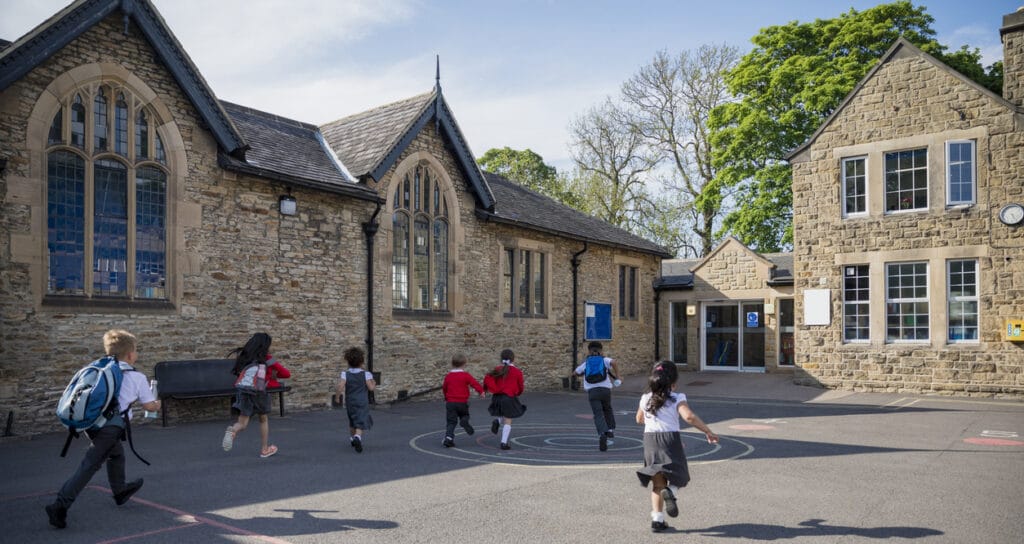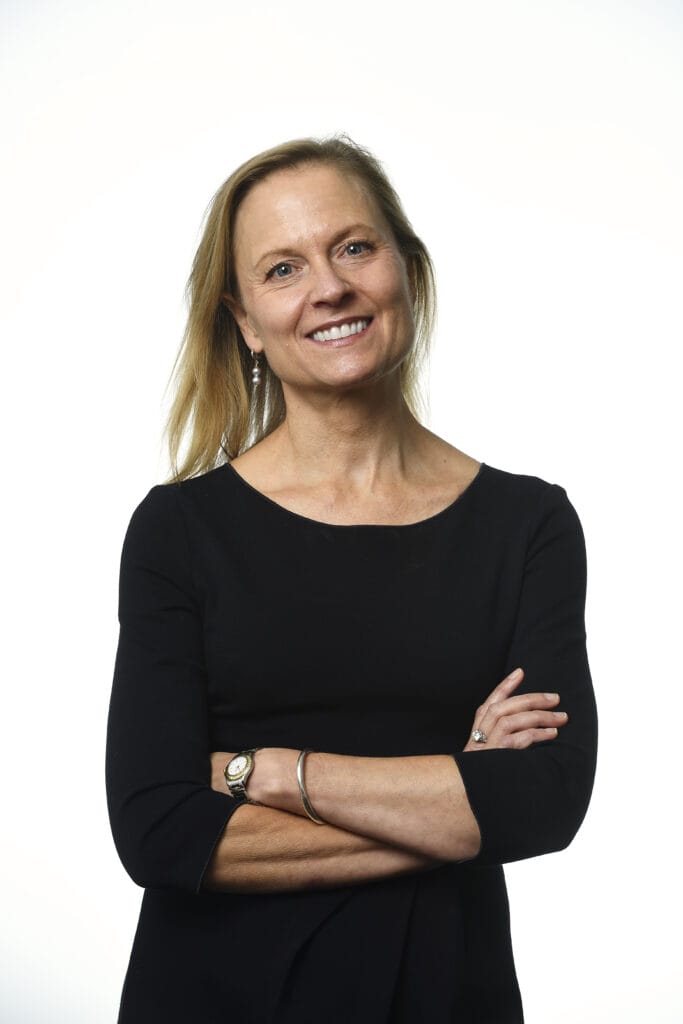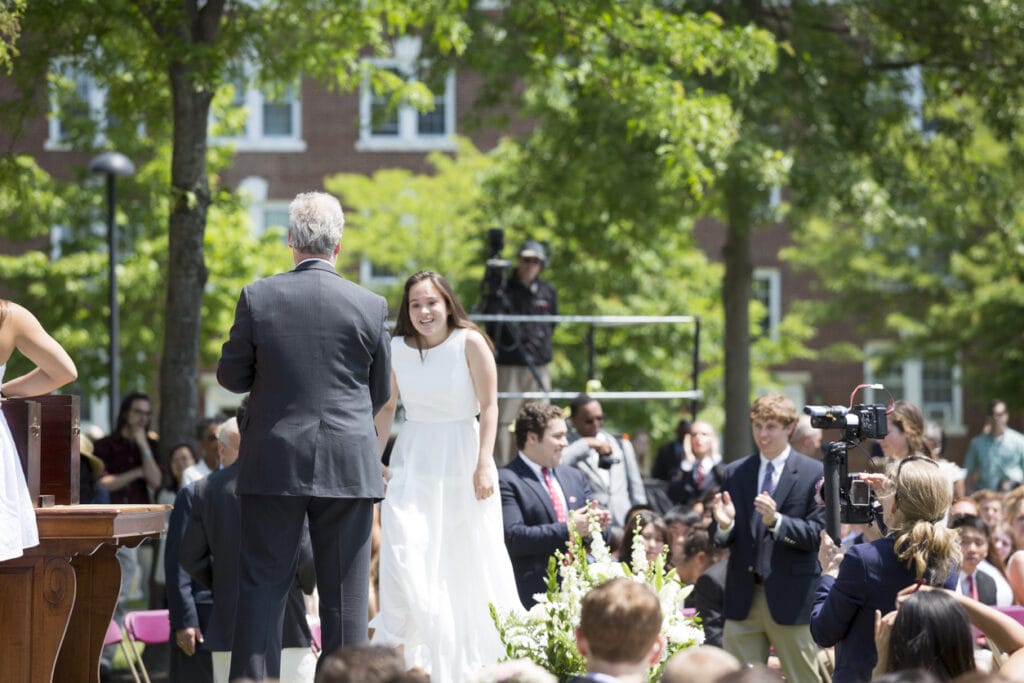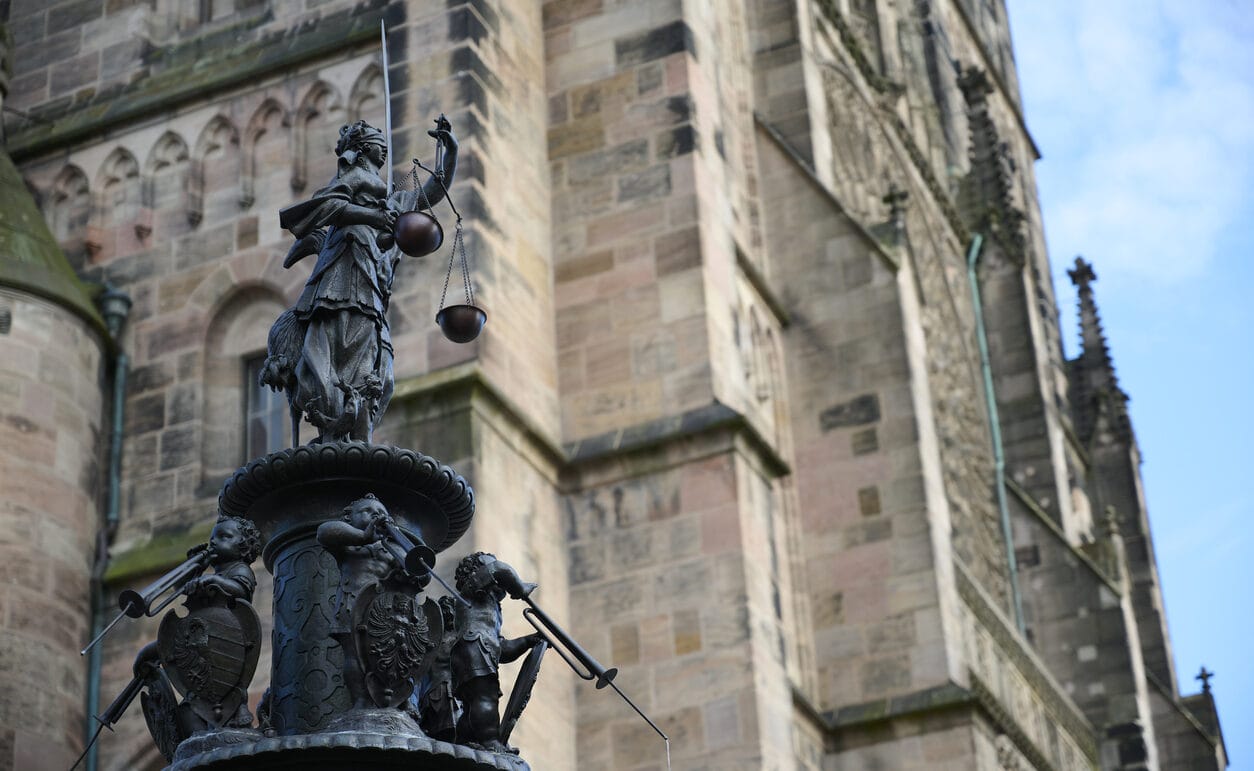A democratic education revisited

Ashley Berner is director of the Johns Hopkins Institute for Education Policy and associate professor of education. Palgrave MacMillan released “Pluralism and American Public Education: No One Way to School” in 2017, and Harvard Education Press published her new book, “Educational Pluralism and Democracy: How to Handle Indoctrination, Promote Exposure, and Rebuild America’s Schools,” in April 2024. She recently spoke with American Habits senior editor Ray Nothstine.
What is education pluralism, and why is it good for democracy and restoring the principles and responsibility needed for self-government?

Ashley Berner: That’s a great question. Let me briefly pull back. If you ask the average American, “What’s public education?,” you may get different answers, but our visceral response is going to connect to the neighborhood public school. If you went around the world, perhaps to Netherlands or England, and you asked, “What’s public education?,” they would give you a variety of answers. If you were in the Netherlands, public education would not be just the district school but the Montessori school down the street, the Jewish day school, and the Catholic school that your sister went to.
The mosaic of schools that most democracies fund is really at the core of educational pluralism. Educational pluralism is a different way to structure public education so that the government funds and regulates but doesn’t necessarily deliver public education. In the Netherlands, the state funds 36 different types of schools, and 30% of the kids go to what we would call a district school. The Montessori schools, the philosophical schools, and the religious schools are all funded by the state. The same is true in most provinces of Canada, Australia, Sweden, Norway, Denmark, Belgium, and Poland. Most countries in the world have a public-private partnership for delivering education.
I know you know the name Horace Mann, and isn’t the point of a more compulsory one-size-fits-all public education model supposed to unite us and create good and well-educated citizens who will preserve constitutional democracy? Is that not happening today and might it be dangerous to move away from that model?
Berner: The first principle of why we tax people to fund public education—in democracies at least—has always been to create equal opportunity and to support an educated citizenry. Opportunity and citizenship are the two big reasons and always have been. Now, when we look at the data in our country, we know that these two things are not happening at scale. I’ll give you one statistic. The percentage of high school seniors in our country who are competent or proficient in U.S. history is 12%. We’re not providing the content and the sensibilities and the dispositions that make for democratic formation.
Adults are no better. Very few adults in this country can name the three branches of government. It’s now a minority who can. This gets to the content of education. More on this later.
But what form does public funding take? Do we fund a lot of different kinds of schools, or do we fund one kind of school? Mann was the first to really articulate why we needed a uniform school system – one kind of school, as opposed to many different kinds. He was very concerned about religious divisions. He was uncomfortable about the fact that state and local governments were funding a lot of different schools.

Because in the 19th century, we funded Catholic schools, non-sectarian schools, Congregationalist schools, Lutheran schools – among others. In New York City, we even funded de facto Jewish schools. Our funding was pluralistic, reflecting the local demography. Interestingly, Mann’s words were not heeded at scale. Very few people wanted to get on board with Mann at the time. It wasn’t until the middle of the 19th century that Americans started to want a uniform system. That came about because of the surge in Catholic immigrants.
When Catholic kids started reaching 50% of the population in some of our big cities like Boston, with tax money going to Catholic schools, the predominate white Anglo-Saxon Protestants felt threatened. That was the culture war of the 19th century, and it’s fascinating and troubling. After the Civil War, we had the convergence of anti-immigrant nativist groups and politicians who made what I would consider an unholy alliance against Catholic schools. Mann’s vision was realized after the American Civil War as legislature after legislature capitulated to nativism and funded one kind of school.
Now, from our 21st century perspective, the current model is all we’ve known. Our education policy debates are set in this public versus private binary, and it’s extremely difficult to move away from that mental model, even in arguing for “choice.” It’s “choice” against the norm of uniformity.
One of the biggest complaints about traditional public education is that it’s more politicized than ever. That makes sense given large segments of life are increasingly politicized and that makes its way into the classroom. Families have different values. I know pluralism addresses that and makes us more democratic in terms of choice but is there a concern that it might fester divisions or make them even more entrenched?
This is a fair concern. Social cohesion – having a common conversation and a common identity – is always a concern in pluralistic countries. Education policy must figure out how to honor the diversity of beliefs and opinions that we have, while also building a common framework for life as a nation.
I would say this is where pluralism is particularly helpful because educational pluralism separates the ethos of the school from the content of the school. Honoring diverse parents’ viewpoints or students’ needs—it’s not just about religion and secularism, it’s about philosophy, pedagogy, and the class size. There are 1,000 reasons why a given school doesn’t work for a particular child – and pluralism tries to honor that diversity.
But at the same time, pluralism says, “We’re all in this together, this project of building the next generation and sustaining democracy.” That has a consequence, meaning we must have a common understanding of academic success. That is the second reason I’m so attracted to pluralism, because while the best systems don’t require a lockstep curriculum, they do require a liberal arts conversation in all the classrooms. It can be delivered through the lens of the school, but there’s a certain level of content that all kids must master.
I can give you a concrete example. The Netherlands, as I said, funds 36 different kinds of schools. They also fund, among those, creationist schools. Yet, every child in a creationist school at some point must demonstrate competent knowledge of evolutionary theory. The same principle applies for a subject like comparative religion. Germany and Switzerland—and most European countries—fund all different types of schools, but they also require comparative religion and ethics every year in all of them. This is totally different from how the United States has been for 100 years, right?
In other words, these systems don’t confuse exposure with indoctrination. When I lived in England, my kids went to a Catholic girls’ school. They all learned about Hinduism, and they all learned—in the upper grades—about socialism and Marxism. It’s part of being an educated citizen. That’s different from compelling belief, which should never happen.
Do you think there is any validity to the argument that part of the hesitancy for a more pluralistic education model is that it threatens the desire for a captive audience for potential indoctrination? The big choice opponents are teachers’ unions and the educational bureaucratic complex so to speak, but do some simply just want a one-size-fits-all system for purely ideological power/control? Is that too cynical of a take? I say that because I think there are a lot of ideologues that want to compel people to think a certain way.
Berner: One of the wonderful things about pluralism is that it diminishes the likelihood of a zero-sum game. It makes room for all of us.
On ideology, it’s important to note that education is not neutral. It is inherently about values, and this applies whether the values are religious or secular or simply consumer culture writ large. Instead of pretending that education can be neutral and then fighting to the death about the content, we need to say, “Okay, because education can’t be neutral, we’re going to fund a wide variety of school types.” That diffuses both the fear and the need to control.
Now, people in pluralistic countries still fight about education, but it’s not this zero-sum game power structure. It’s the both/and of diverse schools and more common content.
That’s where I would put my hope, in a diverse delivery system so that you’re funding all different kinds of schools while insisting on some degree of common content because that is the biggest way to close achievement gaps, by requiring a high-quality curriculum that all kids have access to.
I’m very interested in moral formation, and not just this generic, “be kind” moralism. How important is faith-based education for a healthy republic? Is that something families should have access to if they desire it? It seems silly to me to tell your children that spiritual formation is central to your life and then not get any of that in school.
Berner: I do think there’s a lot of evidence that schools with distinctive missions have an outsized positive impact on kids’ academic, philosophical and/or religious, and civic formation. This is true not just in our country, but around the world. As my friend Charlie Glenn said, “Schools with a distinctive identity offer educational advantages deriving from their clarity of purpose.”
When you think about the organic school community, where parents can join a community because they agree with the message, where it’s clear, it’s mission-minded—instead of the pretense of neutrality—that’s a positive good for kids. Academically and psychologically, too.

I’m about to release a paper called “The Progressive Case for Educational Pluralism.” One of the points that progressive legal scholars in the ’60s and ’70s homed in on was that the aim for public education to be values-neutral had led to an ethic of banality, an ethic of non-commitment, which simply reflected the consumer culture of America. This is not good for children’s moral development.
They cite Lawrence Kohlberg, who wrote about ego strength and how important it is that there’s some overlapping messaging from adults in the school and so forth, by extension, so that kids have a place to stand from which to critique, from which to engage, from which to turn over diverse viewpoints.
Strong school culture is important not only for private and charter schools, but for districts. Some districts, such as Miami-Dade and San Antonio, are helping schools differentiate, and it is precisely because that clarity of focus helps all the adults and the kids.
This might be more of a personal observation with a large chunk of the current education system and times spent on screens now and automated learning, but is there a real concern that we are not teaching young people critical thinking skills and how to reason? There is a dearth of intellectual diversity, perhaps. Does that make sense?
Ashley Berner: I have real concerns about the impact of many hours on social media on young people. For instance, Jonathan Haidt at NYU has done tremendous work on how devastating it’s been, particularly for young girls, to have a constant influx of perfectionistic images hurled at them.
The other point is that American education always wants to go after the shiny new object. In the ’50s, it was striving for a TV in every classroom, and then it was a screen in every hand. Those mechanisms and methods still beg the question, what are you conveying? What knowledge are you conveying through whatever instruments these are? That’s where we have a massive hole at the heart of American education.
My new book has two chapters on this history; it’s that important. More than 100 years ago, American education had a high-level decision to make about the content of the classroom. Will we continue to democratize the liberal arts, give every kid access to a wide range of literature and history and science, and require them to learn geography and memorize capitals and understand mathematical concepts and so forth? Or are we going to focus on process, the skills of finding the main idea, the skills of learning how to learn, instead? Unfortunately, we chose process over content.”
I want to home in on what you said about critical thinking, and here, I’ll quote my colleague, David Steiner, “You can’t think critically about nothing in particular.” You must have real content. You must understand different viewpoints before you can engage critically on the merits of each. This is why successful school systems have intentional knowledge-building at the heart of the curriculum.
Even in this country, we see great things happening when school systems go for rigorous systematic knowledge building. Just look at what happened when Chicago Public Schools put the International Baccalaureate Diploma Program in their low-performing high schools. The kids who went through four years of this rigorous curricular approach had a 40% greater chance of going to college. It’s a game-changer.
I could give you so many stories of good things that happen when systems pull this powerful lever of knowledge-rich content.
Incidentally, this is a reason why I would say that “school choice” is necessary but insufficient. If we don’t pay attention to academic quality, we’re going to end up with lackluster results.
I wrote a piece years ago that school choice ultimately doesn’t matter if you can’t answer the basic question, “What is the purpose of education?” If you are not answering the basic question of purpose, then you could have all the reforms you want, but you’re not going to make a serious dent in knowledge and achievement.
Berner: I could not agree with you more.
Both sides get messed up on this. On the left, you hear the argument, “You can’t have charters and choice because that robs the district school.” On the right, you hear everything centered on parent autonomy. Parent choices and the district school are the means to the end of an educated citizenry. We confuse the means and the end. We’re missing a great opportunity to help all schools improve by focusing on systematic academic experience. My institute at Johns Hopkins works on this all the time. We have a real focus on the instructional core and how—whatever else is going on—we tend to ask teachers to do too much. They’re being asked to be social workers. They’re being asked to be psychologists.
If you’re not providing that systematic access to rigor, what are you doing? You’re missing the point.
Expanding on that, what do you think of all the reform happening at the state level related to school choice? What’s good? What needs to be improved? You talked a little bit about academic accountability or curriculum accountability. I guess one example for me in North Carolina, we’ve expanded opportunity to scholarships, but it’s still only for low-income families. What do you see with a lot of the grassroots change and transformation that’s going out there? Obviously, there’s a lot of good there.
Berner: I think you said a moment ago that choice plus academic accountability are two sides of the same important coin. It’s not ideal to have one without the other. In the United States, we have not done a great job with accountability; we’ve made it about skills, or we’ve made it about criticizing teachers.
In answering your question about all the changes, I am in favor of school choice. I don’t use that term in my writing, but I do think it’s essential for parents to have meaningful agency.
When you look at the international human rights documents, parents’ cultural rights are built in there. It’s an international norm. One hundred and seventy-one out of the 204 countries that UNESCO works with have this both-end approach: giving parents choices and agency, while requiring that the state be a guarantor of excellence at the end of the day. It’s very hard to do. Very easy to say, very hard to do. Looking across all the different state policy initiatives, we’re moving in the right direction with respect to choice. I worry, though, that we’re not sufficiently mindful of quality. That’s my number one worry. In the long run, a lack of accountability is not a good approach.
What have you learned from your years of study and research on education that you wish more Americans knew about?
Berner: I wish most Americans knew that we are anomalous, that most countries don’t have this public-private binary. Most countries don’t compare entire kinds of schools to one another. They wouldn’t think of comparing Catholic and charter school performance. They don’t compare district and charters. It’s not part of their mindset, because their job is to make all schools better. I wish Americans knew that there were other ways to do things and that, in fact, most countries have gone that other route. I hope that will bring more air into the room.



